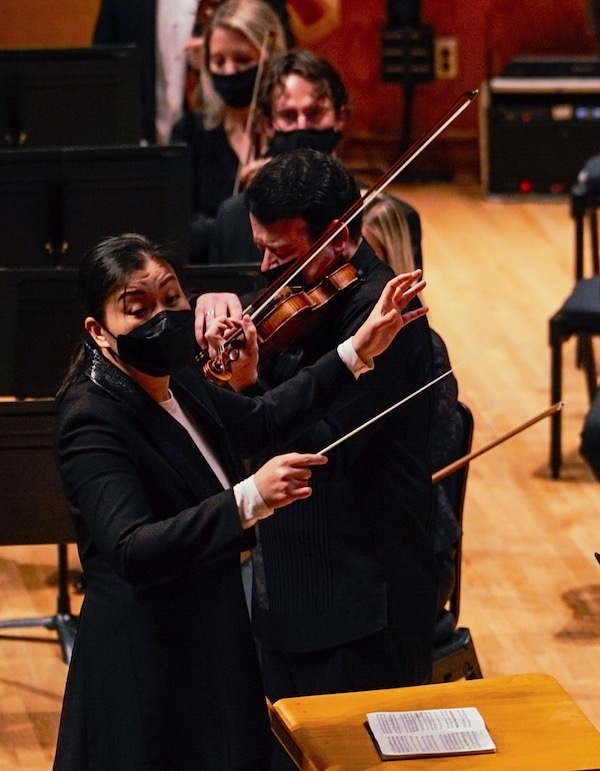Shiyeon Sung quietly shines in Utah Symphony debut

The fourth guest conductor — and first female – this season for Utah Symphony, Shiyeon Sung of South Korea did not arrive at Abravanel Hall on Friday night straight from central casting, as the saying goes. Given how shockingly few female conductors helm major orchestras, and the related tendency to visualize imposing male figures in the role, central casting might well have sent over someone like Rune Bergmann, the tall Norwegian who guest conducted earlier this month.
But Sung’s unassuming presence in her turn at the podium on Friday only accentuated the joy of experiencing her astonishing power and artistry.
In a smart black pantsuit with tails over a white crew-neck top, Sung broke the ice with the audience by shyly introducing herself and composer Arlene Sierra — whose piece Aquilo opened the program — and by asking Sierra to say a few words. Sierra explained that her piece was named after the classical word for the northeast wind and inspired by the ancient Roman architect Vitruvius’s theory that wind came from fire and water mixing past the edge of a flat earth. She described this theory as “charming and lovely in how wrong it is.”
This disarming exchange set the tone for the concert itself. And Sierra’s piece was more than merely “charming and lovely.” Employing the orchestra in a wholly original way, it evoked the fearsome mystery of the wind as it might have appeared to the ancient mind. Though clearly atonal and hinting at serialism, Aquilo was quite accessible and at times reminiscent, in its rhythmic drive and sense of motion, of John Adams’ Short Ride in a Fast Machine. At other times the mood was ethereal, and still at others fierce and angry. Sung had an astute sense of the piece and conducted it with clarity and lucidity, never losing sight of the melody as it ricocheted through the orchestra in odd combinations.
The concert’s centerpiece was Prokofiev’s genial Violin Concerto No. 2, with soloist Vadim Gluzman in a return visit to the Utah Symphony. Gluzman’s technique was dazzling and his phrasing exquisite, but the most striking feature of his performance was the way he collaborated with Sung and the orchestra. Their agile, spontaneous interpretation gave life to the reserved, canonical first movement and to the sweet, lyrical second movement that marked the piece’s high point.
The second movement features a longing melody over a repeated sequence of four triads, starting staccato in the clarinets and then returning legato in the strings. Gluzman’s interpretation of the melody was profoundly expressive without dipping into sentimentality, and Sung reflected his interpretation back to him when the melody shifted to the orchestra.
In the more strident third movement, Gluzman and Sung took cues from each other and grew the piece organically to the climax, which brought the audience to its feet. Gluzman repaid the enthusiastic response with an encore of the Sarabande from Bach’s Partita No. 2 in D minor.
The concert’s second half was devoted to Tchaikovsky’s fatalistic Symphony No. 4, which showcased Sung’s unique ability to breathe life and originality into one of the most ubiquitous pieces in the standard repertoire. Starting with a crisp, stately rendition of the opening fanfare, Sung gave the first movement an underlying architecture that supported her nuanced, intelligent take on each of the main themes. Her phrasing was understated, yet it built to fierce climaxes, and she was free enough with the tempo to let the more contemplative passages breathe and the more frenetic passages reach their destination urgently.
Sung approached the slow second movement like someone building a cathedral. The statement of the main theme in the oboe was clear and legato, but the phrasing was understated, allowing space for theme to grow and develop when it was repeated in the strings and winds, and to swell rapturously into the thick chords of the second theme. The orchestra rose to the movement’s first climax, then the energy dissipated and allowed for the return of the first theme with a wittier, brighter character. Throughout all the tempo changes, development and thematic permutations, Sung resisted the urge to sentimentalize: Every climax and emotional flourish was earned, rendering it all the more powerful and beautiful.
In the breathtaking third and fourth movements, Sung raised the technical level of the orchestra, achieving a clear articulation and phrasing through the extended pizzicato passages and taking the more urgent passages at a breathtaking speed. The orchestra stayed with her as she cued them with expressive movements of hands and fingertips, and at the triumphant finale it was clear that conductor and ensemble had left everything on the stage.
With maestro Thierry Fischer nearing the end of his contract, every guest conductor invites speculation as a replacement. In affording Sung the consideration she deserves for this role, the powers that be would do well to remember that in the late 1990s, Marin Alsop was the only woman who auditioned to replace Joseph Silverstein as Utah Symphony music director, and to consider what it would have been like to have caught that rising star.
The program will be repeated 7:30 p.m. Saturday in Abravanel Hall. utahsymphony.org

